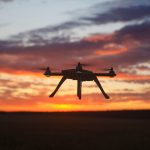CAPE MAY – The next time you see a hummingbird hovering near your window, look again. It just might be an unmanned aerial system (UAS) or drone so tiny that it can fit comfortably in the palm of the hand.
Then again, the next airplane seen in the skies over Cape May County may be a “slightly” larger model drone with a 32-foot wingspan capable of carrying a 150-pound payload.
The Second Annual UAS Conference held in Cape May Oct. 13 and 14 showcased those unmanned systems and other equipment, including drone flight simulators and other air application platforms.
The conference blended academics, government, and private sector organizations to discuss opportunities that many South Jersey leaders, including the county freeholders, believe will be a new UAS technology center based at the Cape May County Airport.
According to Delaware River Bay Authority (DRBA) Executive Director Scott Green and Freeholder William Morey, opportunities for start-up companies and existing firms are growing dramatically in southern Cape May County.
Just as the level of participation in this UAS conference nearly doubled from last year’s inaugural event at the NAS Wildwood Museum, Erma. “Last year we had trouble getting 100 attendees; this year we have 180, and this reflects on the UAS work that is being done here,” Green said.
Green noted that building construction going on at the airport is evidence of the increased level of interest he is receiving from companies that want to join others in developing new technologies or develop new applications for existing technologies.
Green declined to name any of the companies that have come forward because negotiations are still ongoing, but he indicated that there are “several” that want to become part of the new UAS environment at the airport.
Morey added, “The interest shown by companies to relocate here is a natural gathering of like-minded entrepreneurs who gravitate together, not unlike what has occurred in the Silicon Valley area of California.”
The conference featured panel discussions. They included ways that UAS start-ups could be put together with end users who want to use UAS technology in public safety and to conduct bridge inspections.
Other uses include mapping tasks, delivery of emergency supplies after disasters, and acting as cell phone relay platforms where cellular technology is spotty.
Another use would provide new methods to environmentalists in tracking wildlife migration patterns and populations in remote areas. The conference also addressed regulatory issues including the newly implemented Federal Aviation Administration Small UAS Rule 107 that covers small drone registration requirements and operating regulations. Some start-up companies offer three-day training programs for prospective drone pilots that include a “ground school” component to learning such topics as aerial navigation and charting, FAA rules, and operating techniques similar to a private pilot program.
Other discussions focused on the need for UAS service providers to be especially sensitive to the ethics of accepting certain UAS requests from persons or companies that may violate security or privacy rules to make money.
Safety concerns were also discussed. Emphasis was placed on the fact that drones can do significant damage and injure people if recklessly used.
Panelists stressed that the reputation of the UAS industry depends on safe and ethical use of technology to gain and retain the confidence of users, clients, and the public
Dr. Joseph Salvatore, who co-hosted the initial UAS conference at the NAS Museum, expressed his support for the obvious growth of this technology at the airport. “I am delighted to see the progress of the UAS initiative and the museum is in full support of the conference and ongoing initiatives.”
Salvatore mentioned that the museum already had a Tiger Shark drone on display and hoped to receive another from NAVCAR shortly.
“When can we expect to see package deliveries conducted by drones?” That question was asked based on recent media coverage of Amazon’s foray into this futuristic concept that recently captured much attention. The consensus was that FAA air traffic control issues, safety, as well as technology refinements would delay the use of drones for that purpose for at least 10 years.
By that time, officials hope that Cape May County will have developed into a major player in the new technology and that high tech employment opportunities will become one anchor for the economic health of the county in the future.
To contact Jim McCarty, email jmccarty@cmcherald.com.
Wildwood Crest – Several of Donald Trump’s Cabinet picks have created quite a bit of controversy over the last few weeks. But surprisingly, his pick to become the next director of the FBI hasn’t experienced as much…








